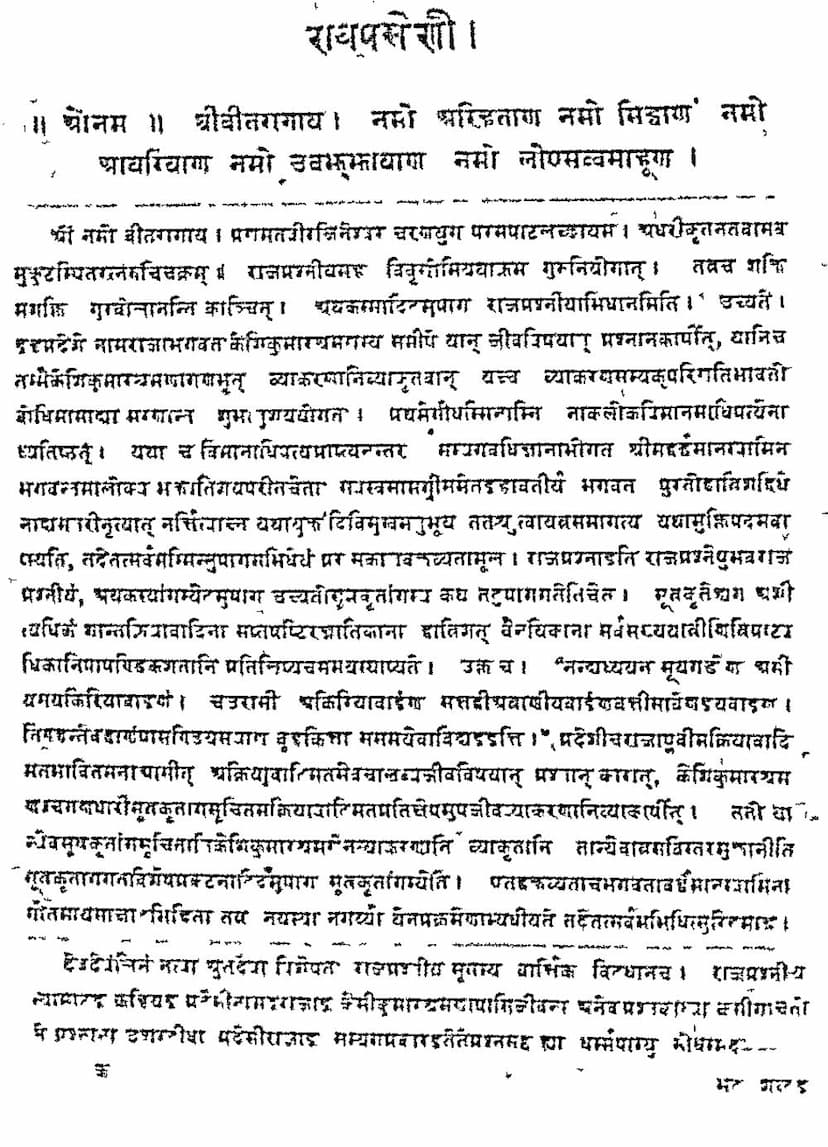Agam 13 Upang 02 Rajprashniya Sutra Shwetambar
Added to library: September 1, 2025

Summary
Here's a comprehensive summary of the provided Jain text, the Rajprashniya Sutra (Agam 13 Upang 02), based on the text itself:
Overall Context and Purpose:
The Rajprashniya Sutra, presented in this excerpt from the Shwetambar tradition, is a discourse that takes place in the city of Amalakalpa during the time of Lord Mahavir. It appears to be a foundational text within the Jain Agamas, likely an Upanga, which elaborates on core Jain teachings and principles. The text is structured as a dialogue, primarily between Lord Mahavir and his disciple Gautam Swami, but also involves discussions with celestial beings and a king. The goal is to explain complex Jain philosophical concepts, particularly related to the soul, karma, rebirth, and the path to liberation, in a clear and accessible manner, often through illustrative narratives and descriptions.
Key Themes and Content:
The provided text focuses heavily on:
- The Nature of the Soul and Existence: The dialogue delves into the soul's (jiva) existence, its distinction from the non-soul (ajiva) or physical body, and the concept of rebirth. It addresses how actions (karma) influence the soul's journey through different life forms and realms.
- Lord Mahavir's Enlightenment and Teachings: The text highlights Lord Mahavir's supreme knowledge (Keval Gyan) and his ability to perceive all states of existence (all-knowing and all-seeing). His teachings are presented as the ultimate truth and the path to liberation.
- The Celestial Realm and its Inhabitants: There's a detailed description of the celestial realm, particularly the Saudharma Kalpa and the palace of the deity Suryabh. This includes elaborate descriptions of the palace's architecture, its assembly halls, the types of deities (Samayika, Agramahishi, etc.), their celestial vehicles (Yan Vimana), their attributes, and the opulent lifestyle they experience, all of which are presented within the context of karma and its consequences.
- The Importance of Right Faith, Knowledge, and Conduct (Tattva-traya): Although not explicitly detailed in this excerpt, the underlying message emphasizes the Jain path to liberation through adherence to Right Faith (Samyak Darshan), Right Knowledge (Samyak Gyan), and Right Conduct (Samyak Charitra).
- Illustrative Narratives and Descriptions: The text employs vivid imagery to describe the celestial palaces, the deities, their adornments, the musical instruments, and the natural environment. It also uses analogies and stories to explain complex concepts. For example, the discussion about the soul's existence without a body is illustrated through the analogy of the soul's passage through different states of existence.
- The Role of Ethical Principles: While the excerpt focuses on celestial descriptions and philosophical points, the underlying Jain ethical framework is implicit. The descriptions of the deities' existence, though grand, serve as a backdrop to understanding the consequences of actions and the ultimate goal of liberation from the cycle of birth and death.
- The Discourse on Right and Wrong Actions: The text implicitly contrasts actions that lead to positive karmic influx (good deeds) and those that lead to negative karmic influx (bad deeds), emphasizing the importance of virtuous actions and the consequences of unrighteous conduct.
- The Concept of Karma: The cyclical nature of birth, death, and rebirth is directly linked to the accumulation and fruition of karma. The text suggests that the soul's journey is dictated by its karmic ledger.
Structure and Style:
The text is presented in a narrative and discursive style. It often follows a dialogue format, with questions posed by disciples like Gautam Swami and answers provided by Lord Mahavir. The descriptions are often elaborate and sensory, painting a picture of both the human and celestial realms. The language, being in Prakrit, includes specific terminology and phrasing common in Jain scriptures. The use of "evam" (thus) and "tataḥ" (then) indicates a sequential narration of events and teachings. The repeated emphasis on "tam" (that) and "tam" (it) signifies pointing to specific concepts or entities being discussed.
Key Figures:
- Lord Mahavir: The central figure, the enlightened one, who delivers the teachings.
- Gautam Swami: Lord Mahavir's chief disciple, who often asks clarifying questions.
- Suryabh (or Suryabha): A celestial being from the Saudharma Kalpa whose palace is described in detail.
- Pradeshi King: A human king who, along with his charioteer Chit, is part of the discourse, often serving as a foil or recipient of teachings related to worldly attachments and actions.
- Chit Sarathi: Pradeshi King's charioteer, who plays a role in conveying the king's understanding and actions.
- Kesi Kumar Shraman: A sage who is depicted as having attained great spiritual knowledge and who clarifies certain points for Pradeshi King and others.
- Various Deities and Celestial Beings: Mentioned in the context of the celestial realms and their activities.
Specific Highlights from the Text:
- Detailed Description of Suryabh's Palace: The text dedicates a significant portion to describing the architecture, dimensions, constituent materials (various gems), celestial gardens, assembly halls, and the opulence of Suryabh's celestial abode.
- The Four Types of Human Beings (Varga): The text touches upon the concept of different types of human beings, likely categorized based on their spiritual development or karmic tendencies, which influences their destinies and experiences.
- The Concept of 'Achala' and 'Achaliya': The text might refer to the unmoving or eternal nature of certain spiritual truths or realms, contrasting with the transient nature of the material world.
- The Importance of Conduct and Virtue: The narratives, even when describing celestial events, often carry moral lessons about the consequences of actions, the importance of virtue, and the path to spiritual advancement.
In essence, the Rajprashniya Sutra, as presented here, serves as a detailed exposition of Jain cosmology, ethics, and philosophy, using the celestial realm and interactions with various beings to illustrate the universal principles governing existence and the path to ultimate liberation.